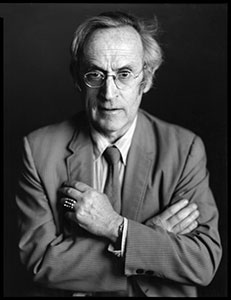Joop Sanders
Obituary Reports the death of an individual, providing an account of the person’s life including their achievements, any controversies in which they were involved, and reminiscences by people who knew them.

Dutch American painter Joop Sanders, a founding member of the Abstract Expressionist art movement and the youngest of the first wave of New York School artists, died July 6 at his home in Putnam Valley. He was 101.
An early force in the New York art world, Sanders effectively vanished from the American scene –and from art history books – when he decamped for Europe in the mid-1950s, just as Abstract Expressionism was exploding in the popular imagination. On his return in 1959, he turned to monochromatic paintings, which he created in segments that could be rearranged to form sculptures of a kind. It was these signature works that ultimately gained him broad acclaim, with critic Joseph Masheck writing of Sanders more than 20 years later, “It is nice to see somebody stick to his guns and have the world catch up.”
Joop Sanders was born on Oct. 6, 1921, in Amsterdam, the son of a prominent attorney. At the age of 17, he emigrated alone to the U.S. to escape the Nazi advance, while his family chose to remain behind. His parents and two sisters survived the Holocaust, the former going into hiding and the latter interned in a work camp. An older sister was killed at the Polish extermination camp Sobibor.
On his arrival in New York, Sanders began a course of study at the Art Students League under George Grosz. A chance meeting at a concert in 1940 led to a friendship with Willem and Elaine de Kooning, with the latter portraying him extensively in her work. In the early 1940s, Sanders began attending informal artists’ gatherings at the Waldorf Cafeteria on Sixth Avenue near Eighth Street; the unstructured meetings would eventually coalesce into the Club, of which he was the youngest founding member along with 19 other artists, including the de Koonings, Franz Kline, Ibram Lassaw and Milton Resnick.
Sanders in 1951 exhibited the painting “Death and Entrances,” made that same year, in the seminal Ninth Street Show, the first group exhibition of the New York School artists, organized by Club member Leo Castelli. In 1955, having married and obtained U.S. citizenship, he moved with his family to Europe, where he would remain for the next four years, exhibiting widely across the continent, including at the Stedelijk in Amsterdam, where in 1960 he became the first young American artist ever awarded a solo show.
Sanders additionally exhibited alongside the Zero Group there, in shows curated by Enrico Castellani and Piero Manzoni. Though the move cemented his reputation in Europe, it proved to be detrimental to his career in America, as his departure at the cusp of Abstract Expressionism’s success meant that he was frequently overlooked in comparison with his fellow painters of the movement, alongside whom he had initially risen.
Following his 1959 return to New York, Sanders became an early resident of SoHo, where he began focusing on monochrome canvases of allover fields, which often bore rounded edges. Many of these works, which grew larger in later years, were composed of several panels, the arrangement of which Sanders left up to a given work’s owner.
“These paintings are like spirit photographs in which the spirit reaches out and touches the viewer,” wrote Lawrence Campbell in a 1987 issue of Art in America.
In addition to his lengthy career as a painter, Sanders was a tenured professor of painting at SUNY New Paltz. He was also a visiting artist at Haystack Mountain School, Cooper Union, Pratt Institute, Carnegie Tech in Pittsburgh and the University of California, Berkeley. His work is held in the collections of the Madison Museum of Contemporary Art, Wisconsin; the Milwaukee Art Museum; the Museum of Modern Art, New York; the Philadelphia Museum of Art; and the Stedlijk, among other institutions.
Sanders was married for 68 years to the lieder singer Isca Sanders-Jörgensen (1925–2019). Among his survivors are his daughter Karin Greenfield-Sanders; his son, sculptor John Sanders; two granddaughters, painter Isca Greenfield-Sanders and filmmaker Liliana Goldwyn; and five great-grandchildren.

Examiner Media – Keeping you informed with professionally-reported local news, features, and sports coverage.
